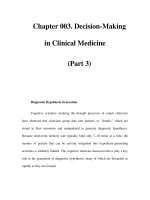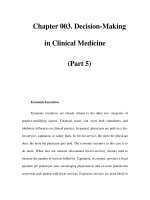Chapter 003. Decision-Making in Clinical Medicine (Part 2) pdf
Bạn đang xem bản rút gọn của tài liệu. Xem và tải ngay bản đầy đủ của tài liệu tại đây (25 KB, 5 trang )
Chapter 003. Decision-Making
in Clinical Medicine
(Part 2)
The following three examples introduce the subject of clinical reasoning:
A 46-year-old man presents to his internist with a chief
complaint of hemoptysis. The physician knows that the differential
diagnosis of hemoptysis includes over 100 different conditions, including
cancer and tuberculosis. The examination begins with some general
background questions, and the patient is asked to describe his symptoms
and their chronology. By the time the examination is completed, and even
before any tests are run, the physician has formulated a working diagnostic
hypothesis and planned a series of steps to test it. In an otherwise healthy
and nonsmoking patient recovering from a viral bronchitis, the doctor's
hypothesis would be that the acute bronchitis is responsible for the small
amount of blood-streaked sputum the patient observed. In this case, a chest
x-ray may provide sufficient reassurance that a more serious disorder is not
present.
A second 46-year-old patient with the same chief complaint
who has a 100-pack-year smoking history, a productive morning cough,
and episodes of blood-streaked sputum may generate the principal
diagnostic hypothesis of carcinoma of the lung. Consequently, along with
the chest x-ray, the physician obtains a sputum cytology examination and
refers this patient for fiberoptic bronchoscopy.
A third 46-year-old patient with hemoptysis who is from a
developing country is evaluated with an echocardiogram as well, because
the physician thinks she hears a soft diastolic rumbling murmur at the apex
on cardiac auscultation, suggesting rheumatic mitral stenosis.
These three simple vignettes illustrate two aspects of expert clinical
reasoning: (1) the use of cognitive shortcuts as a way to organize the complex
unstructured material that is collected in the clinical evaluation, and (2) the use of
diagnostic hypotheses to consolidate the information and indicate appropriate
management steps.
The Use of Cognitive Shortcuts
Cognitive shortcuts or rules of thumb, sometimes referred to as heuristics,
can help solve complex problems, of the sort encountered daily in clinical
medicine, with great efficiency. Clinicians rely on three basic types of heuristics.
When assessing a particular patient, clinicians often weigh the probability that this
patient's clinical features match those of the class of patients with the leading
diagnostic hypotheses being considered. In other words, the clinician is searching
for the diagnosis for which the patient appears to be a representative example; this
cognitive shortcut is called the representativeness heuristic.
It may take only a few characteristics from the history for an expert
clinician using the representativeness heuristic to arrive at a sound diagnostic
hypothesis. For example, an elderly patient with new-onset fever, cough
productive of copious sputum, unilateral pleuritic chest pain, and dyspnea is
readily identified as fitting the pattern for acute pneumonia, probably of bacterial
origin. Evidence of focal pulmonary consolidation on the physical examination
will increase the clinician's confidence in the diagnosis because it fits the expected
pattern of acute bacterial pneumonia. Knowing this allows the experienced
clinician to conduct an efficient, directed, and therapeutically productive patient
evaluation since there may be little else in the history or physical examination of
direct relevance. The inexperienced medical student or resident, who has not yet
learned the patterns most prevalent in clinical medicine, must work much harder to
achieve the same result and is often at risk of missing the important clinical
problem in a sea of compulsively collected but unhelpful data.
However, physicians using the representativeness heuristic can reach
erroneous conclusions if they fail to consider the underlying prevalence of two
competing diagnoses (i.e., the prior, or pretest, probabilities). Consider a patient
with pleuritic chest pain, dyspnea, and a low-grade fever. A clinician might
consider acute pneumonia and acute pulmonary embolism to be the two leading
diagnostic alternatives. Using the representativeness heuristic, the clinician might
judge both diagnostic candidates to be equally likely, although to do so would be
wrong if pneumonia was much more prevalent in the underlying population.
Mistakes may also result from a failure to consider that a pattern based on a small
number of prior observations will likely be less reliable than one based on larger
samples.
A second commonly used cognitive shortcut, the availability heuristic,
involves judgments made on the basis of how easily prior similar cases or
outcomes can be brought to mind. For example, the experienced clinician may
recall 20 elderly patients seen over the past few years who presented with painless
dyspnea of acute onset and were found to have acute myocardial infarction. The
novice clinician may spend valuable time seeking a pulmonary cause for the
symptoms before considering and then confirming the cardiac diagnosis. In this
situation, the patient's clinical pattern does not fit the expected pattern of acute
myocardial infarction, but experience with this atypical presentation, and the
ability to recall it, can help direct the physician to the diagnosis.
Errors with the availability heuristic can come from several sources of
recall bias. For example, rare catastrophes are likely to be remembered with a
clarity and force out of proportion to their value, and recent experience is, of
course, easier to recall and therefore more influential on clinical judgments.
The third commonly used cognitive shortcut, the anchoring heuristic,
involves estimating a probability by starting from a familiar point (the anchor) and
adjusting to the new case from there. Anchoring can be a powerful tool for
diagnosis but is often used incorrectly. For example, a clinician may judge the
probability of coronary artery disease (CAD) to be very high after a positive
exercise thallium test, because the prediction has been anchored to the test result
("positive test = high probability of CAD"). Yet, as discussed below, this
prediction would be inaccurate if the clinical (pretest) picture of the patient being
tested indicates a low probability of disease (e.g., a 30-year-old woman with no
risk factors). As illustrated in this example, anchors are not necessarily the same as
the pretest probability (see "Measures of Disease Probability and Bayes'
Theorem," below).









